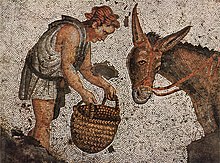Saylor.org's Ancient Civilizations of the World/Culture and Commerce
Culture
[edit | edit source]
The writings of Classical antiquity never ceased to be cultivated in Byzantium. Therefore, Byzantine science was in every period closely connected with ancient philosophy, and metaphysics. Although at various times the Byzantines made magnificent achievements in the application of the sciences (notably in the construction of the Hagia Sophia), after the 6th century Byzantine scholars made few novel contributions to science in terms of developing new theories or extending the ideas of classical authors. Scholarship particularly lagged during the dark years of plague and the Arab conquests, but then during the so-called Byzantine Renaissance at the end of the first millennium Byzantine scholars re-asserted themselves becoming experts in the scientific developments of the Arabs and Persians, particularly in astronomy and mathematics. The Byzantines are also credited with several technological advancements, particularly in architecture (e.g. the pendentive dome) and warfare technology (e.g. Greek fire).
In the final century of the Empire, Byzantine grammarians were those principally responsible for carrying, in person and in writing, ancient Greek grammatical and literary studies to early Renaissance Italy. During this period, astronomy and other mathematical sciences were taught in Trebizond; medicine attracted the interest of almost all scholars.
In the field of law, Justinian I's reforms had a clear effect on the evolution of jurisprudence, and Leo III's Ecloga influenced the formation of legal institutions in the Slavic world. In the 10th century, Leo VI the Wise achieved the complete codification of the whole of Byzantine law in Greek, which became the foundation of all subsequent Byzantine law, generating interest to the present day.
Byzantine art is almost entirely concerned with religious expression and, more specifically, with the impersonal translation of carefully controlled church theology into artistic terms. Byzantine forms were spread by trade and conquest to Italy and Sicily, where they persisted in modified form through the 12th century, and became formative influences on Italian Renaissance art. By means of the expansion of the Eastern Orthodox church, Byzantine forms spread to centres in Russia, Greece, Serbia and some others. Influences from Byzantine architecture, particularly in religious buildings, can be found in diverse regions from Egypt and Arabia to Russia and Romania.
In Byzantine literature, therefore, four different cultural elements must be reckoned with: the Greek, the Christian, the Roman, and the Oriental. Byzantine literature is often classified in five groups: historians and annalists, encyclopaedists (Patriarch Photios, Michael Psellos, and Michael Choniates are regarded as the greatest encyclopaedists of Byzantium) and essayists, and writers of secular poetry (The only genuine heroic epic of the Byzantines is the Digenis Acritas). The remaining two groups include the new literary species: ecclesiastical and theological literature, and popular poetry. Of the approximately two to three thousand volumes of Byzantine literature that survive, only three hundred and thirty consist of secular poetry, history, science and pseudo-science. While the most flourishing period of the secular literature of Byzantium runs from the ninth to the 12th century, its religious literature (sermons, liturgical books and poetry, theology, devotional treatises etc.) developed much earlier with Romanos the Melodist being its most prominent representative.
Commerce
[edit | edit source]
The Byzantine economy was among the most advanced in Europe and the Mediterranean for many centuries. Europe, in particular, was unable to match Byzantine economic strength until late in the Middle Ages. Constantinople was a prime hub in a trading network that at various times extended across nearly all of Eurasia and North Africa, in particular being the primary western terminus of the famous Silk Road. Until the first half of the 6th century and in sharp contrast with the decaying West, Byzantine economy was flourishing and resilient. The Plague of Justinian and the Arab conquests, however, would represent a substantial reversal of fortunes contributing to a period of decline and stagnation. Isaurian reforms and, in particular, Constantine V's repopulation, public works and tax measures, marked the beginning of a revival that continued until 1204, despite territorial contraction. From the 10th century until the end of the twelfth, the Byzantine Empire projected an image of luxury, and the travellers were impressed by the wealth accumulated in the capital. The Fourth Crusade resulted in the disruption of Byzantine manufacturing and the commercial dominance of the Western Europeans in eastern Mediterranean, events that amounted to an economic catastrophe for the Empire.The Palaiologoi tried to revive the economy, but the late Byzantine state would not gain full control of either the foreign or domestic economic forces. Gradually, it also lost its influence on the modalities of trade and the price mechanisms, and its control over the outflow of precious metals and, according to some scholars, even over the minting of coins.
One of the economic foundations of Byzantium was trade, fostered by the maritime character of the Empire. Textiles must have been by far the most important item of export; silks were certainly imported into Egypt, and appeared also in Bulgaria, and the West. The state strictly controlled both the internal and the international trade, and retained the monopoly of issuing coinage, maintaining a durable and flexible monetary system adaptable to trade needs. The government exercised formal control over interest rates, and set the parameters for the activity of the guilds and corporations, in which it had a special interest. The emperor and his officials intervened at times of crisis to ensure the provisioning of the capital, and to keep down the price of cereals. Finally, the government often collected part of the surplus through taxation, and put it back into circulation, through redistribution in the form of salaries to state officials, or in the form of investment in public works.
Attribution
[edit | edit source]"The Byzantine Empire" (Wikipedia) http://en.wikipedia.org/wiki/Byzantine_Empire